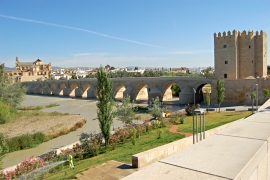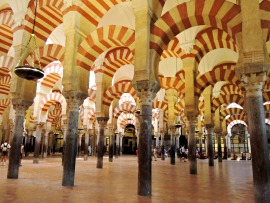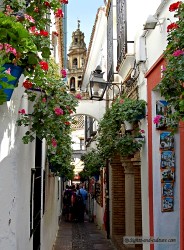| Córdoba is the capital of the province of
Córdoba in the autonomous region of Andalusia, in southern
Spain. It is situated on the banks of the Guadalquivir river, not
far from the Sierra Morenathe mountains, known for their mineral
wealth.
 The city's
history goes back to an Iberian settlement, which was conquered
by the Romans in 169 BC. At the time of Julius Ceasar Córdoba
developed into the most important city of southern Spain. One of
the most beautiful examples of Roman architecture from this time
is the Roman
Bridge over the Guadalquivir River (1st cent. BC), with a length
of about 250 m and 16 arches. With the
Moorish conquest in 711 Córdoba
came under Arab rule for hundreds of years, in fact until 1236. The city's
history goes back to an Iberian settlement, which was conquered
by the Romans in 169 BC. At the time of Julius Ceasar Córdoba
developed into the most important city of southern Spain. One of
the most beautiful examples of Roman architecture from this time
is the Roman
Bridge over the Guadalquivir River (1st cent. BC), with a length
of about 250 m and 16 arches. With the
Moorish conquest in 711 Córdoba
came under Arab rule for hundreds of years, in fact until 1236.
At first the city became a provincial capital, subordinate to
the Caliphate of Damascus, but when in 756 the Caliph of Damascus
set up his court at Córdoba, the city's most glorious period
began. It became capital of the independent emirate of Córdoba
(756 - 929) and finally advanced to the head of the Caliphate of
Córdoba (929 - 1031). In the 10th century Córdoba
was the largest, most prosperous city of Europe, outshining Byzantium
and Baghdad in science, culture and the arts.
| In 785 the construction of the Great Mosque of Córdoba
(Mezquita de Córdoba) was begun on the site of a
Roman temple of Janus, which had been converted into a church
by the Visigoths. The building complex was expanded over
the following centuries and finished in 987. With an area
of over 23,000 square meters the Great Mosque of Córdoba
(Mezquita de Córdoba) is one of the largest sacral
buildings in the world. The magnificent, arcaded hypostyle
hall with 856 columns of jasper, onyx, marble, and granite
is of awe-inspiring grandeur. |
 |
| After the reconquest in the 13th century, under Ferdinand
III, the Great Mosque was turned into a cathedral. The most
significant alteration was the building of a Renaissance
cathedral nave right in the middle of the expansive structure
by permission of Charles V, king of Castile and Aragon.
However, when he visited the completed cathedral he famously
commented, "they have taken something unique in all the
world and destroyed it to build something you can find in
any city." |

|

Suggestions for your sightseeing:
Mosque-Cathedral
of Córdoba
Roman bridge of Córdoba
Jewish
quarter
Sinagoga de Córdoba
Puerta del
Puente
Alcázar de los Reyes
Flower Alley,
the Calleja de las Flores
The charming, well-preserved historic centre belongs to the UNESCO
World Heritage, not least because it still to this day gives a vivid
idea of the different cultures that have lived here, at the banks
of the Guadalquivir. An especially enchanting feature are the lovely
patios, typically with a small fountain in the centre and decorated
with beautiful tiles, stone mosaics, plants and flowers. They have
been built troughout history as a way, to keep the homes cool in
the hot climate. Since 1993 every year in May, the city celebrates
its traditional Cordoba Patio Festival, where the most beautiful
patio is elected. Home owners open the heavy iron gates revealing
the breathtaking beauty and flowerage of their elaborately decorated
court yards, windows and walls; a feast for the eyes! In 2012 the
UNESCO declared the festival a Masterpiece of the Oral and Intangible
Heritage of Humanity.
|

